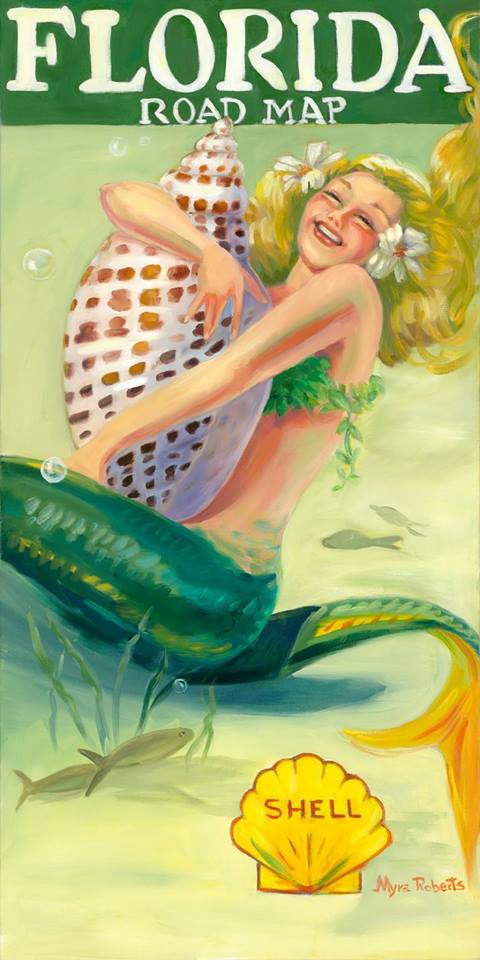- Home
- Florida History
- Florida Regional History
- Southeast Florida Heritage and History
SOUTHEAST FLORIDA
HERITAGE AND HISTORY
Southeast Florida heritage and history has been shaped by many cultures and characters. Thousands of years ago, the Tequesta tribe of Indians lived on Biscayne Bay in what are now Miami-Dade County and south Broward County.
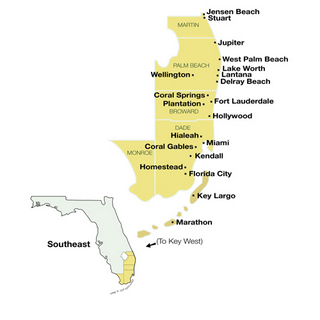
A few of the original Tequesta Indians were in Southeast Florida including some populations along the Florida Keys. Most of these ancient tribes disappeared by the middle of the 1700's.
After that, Bahamians were among the earliest settlers in Southeast Florida. Many of them became the first citizens of what is now Coconut Grove in Miami.
The Indians and Bahamians contributed to what is now Southeast Florida heritage and history.
If the north Florida regions are also known as Florabama and Florgia, then Southeast Florida could be called lower New York or northern Havana or Floracuba.
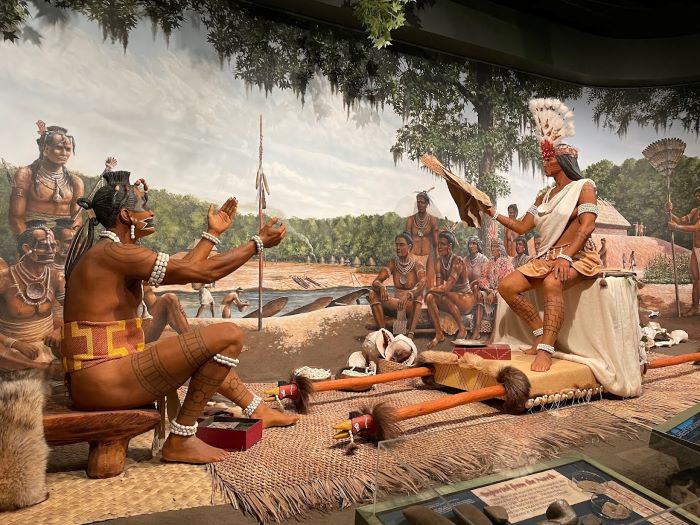 Native American Display
Native American DisplayModern immigrants from the New England states and Latin and Central America give the region its diverse flavor. You can enjoy a New York Pizza, an Argentinian steak, and a Jamaican beef patty and never leave your friendly neighborhood shopping center.
This makes Southeast Florida heritage among the most diverse in the country.
Without the Standard Oil Company, Southeast Florida heritage and history would be entirely different. Henry Morrison Flagler was John D. Rockefeller's partner in that giant firm.
Flagler sold out to Rockefeller and moved to Florida in 1885. He was rich, but like Colonel Sanders he wasn't the kind of man who considered retirement.
His first Florida venture was to build the giant 540 room Ponce de Leon Hotel in St. Augustine. This magnificent building is now the home of Flagler College. The hotel opened in 1888 and was a huge success.
Flagler saw the potential in developing the entire Florida coast south of St. Augustine. He went to work creating what he would refer to as the "American Riviera".
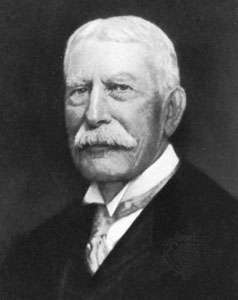 Henry Flagler
Henry FlaglerThe development of Southeast Florida began in earnest when Flagler began to push his Florida East Coast Railway to the south from St. Augustine.
His railroad created Florida history town by town as it marched south. Each town has its share of Southeast Florida heritage brought to it by Henry Flagler.
Before the railroad pushed southward, Southeast Florida was as remote as any place in the United States. Transportation between the coastal communities was by shallow draft boats and paddle wheel steamers.
Flagler's destination was Palm Beach. That's where he planned to end his railroad.
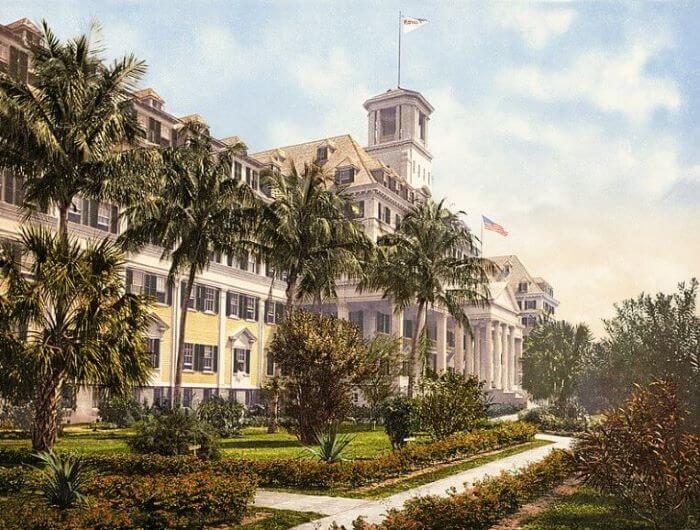 Palm Beach Royal Poinciana Hotel 1900
Palm Beach Royal Poinciana Hotel 1900When the railroad made it to Palm Beach in 1894, he built the 1100 room Royal Poinciana Hotel and a couple of years later the Breakers Hotel.
The Royal Poinciana was the largest hotel in Florida history at the time. At the same time, he developed West Palm Beach as a community where the hotel workers could live.
Flagler might have been content to stop the railroad in West Palm Beach. He didn't have a high opinion of Florida south of Palm Beach. An unusual weather event made him change his mind.
In 1894 and 1895 the Palm Beach area suffered severe freezes. The area down south that now includes Miami did not get the freeze.
Julia Tuttle owned a trading post on the Miami River. The town of Miami didn't even exist yet.
Tuttle had been trying to convince Flagler to run the railroad south to her area. An old Florida history book says that Julia sent Henry an orange blossom to show him that Miami did not suffer a freeze.
Whether the story is true or not, something convinced Mr. Flagler to extend his railroad to Miami. And the rest is Southeast Florida heritage and history.
Later, when he was in his eighties, he pushed on across the Florida Keys and terminated his venture in Key West. Development followed the railroad, and Southeast Florida was transformed.
Palm Beach became the playground of the rich and famous. Fort Lauderdale and Miami expanded west and created some of the first large planned communities.
Miami grew from Julia Tuttle's trading post at the mouth of the Miami River to become the virtual business center for Latin America.
Northerners from New England followed US-1 down the east coast of Florida. Many fell in love with the palm studded coast and decided to stay.
During World War Two, Miami Beach hotels were converted to military barracks. Many of the soldiers and sailors who trained in Miami Beach came back to paradise after the war ended.
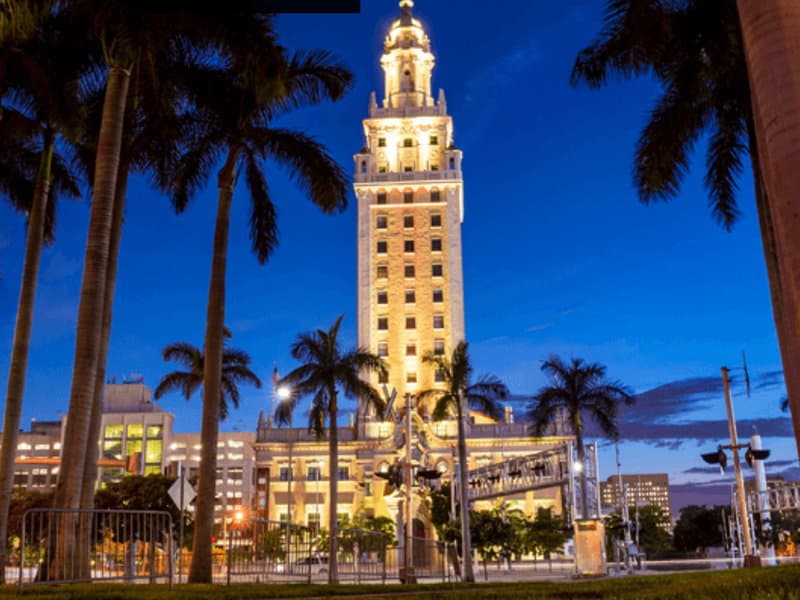 Freedom Tower, Miami
Freedom Tower, MiamiFidel Castro and his communist revolution succeeded in Cuba, and huge waves of Cuban refugees escaped to Miami in the early 1960's. They transformed Miami into a great Latin City.
Castro's loss is Miami's gain. The Latin flair is evident today in the music, festivals and cuisine that are Miami's trademarks.
The people in the Florida Keys march to their own drummer. Maybe that's because it was a series of isolated islands until Henry Flagler changed it all.
Flagler's Florida Overseas Railroad road had been an engineering marvel. The railroad tied the Keys to the mainland for the first time when it was completed in 1912 and forever changed Southeast Florida heritage and history.
Flagler did not live long enough to see his masterpiece completely destroyed by the Labor Day hurricane of 1935.
After the hurricane, the old railroad bridges and track beds became US-1, known in the Keys as the Overseas Highway. Key West still remained, literally, the end of the road.
Early natives of the Florida Keys were originally descended from the Loyalist pioneers of the Bahamas. Many of the family names in Key West and Monroe County are the same as the ones in Abaco, Bahamas.
Before the railroad, keys residents made their livings fishing and "wrecking". Wrecking involved salvaging ships and materials that grounded on the rocky waters around the Keys.
The natives of the lower Keys were always known as conchs, named after the mollusk that was abundant in the waters of Florida and The Bahamas.
That's pronounced "konk", like a konk in the head. Not "conch" like a fat man's paunch.
The Conchs tried to secede from the United States in 1982. They did not succeed in seceding. Many Conchs in recent years have migrated north to Ocala, Gainesville and other rural Florida areas.
There are many back roads in Southeast Florida that are worth traveling. Although most of them are in urban areas, some of them haven't changed much in the past century.
SOUTHEAST FLORIDA HISTORIC SITES
Here is a list of 259 Southeast Florida historic sites listed by county. The County Seat is also listed.

BROWARD: Fort Lauderdale
- African American Research Library and Cultural Center
- Bonnet House Museum & Gardens
- Bryan Building
- Cap's Place
- Croissant Park Administration Building
- Dania Beach Main Street, Inc.
- Deerfield Beach Elementary School
- Dr. Von D. Mizell - Eula Johnson State Park
- Flamingo Gardens
- Graves Museum of Archaeology and Natural History
- Hollywood Boulevard Historic Business District
- Hollywood Woman's Club
- Hugh Taylor Birch State Park
- International Game Fish Association Fishing Hall of Fame and Museum
- International Swimming Hall of Fame
- James D. and Alice Butler House Museum
- Link Trainer Building
- North New River Canal Lock #1
- Nyberg-Swanson House
- Oakland Park Elementary School
- Old Davie School Historical Museum
- Old Deerfield School Museum
- Old Dillard High School
- Old Fort Lauderdale Museum of History
- Pioneer House
- Plantation Historical Museum
- Pompano Beach Historical Society Museum
- Sailboat Bend Historic District
- Sample McDougald House
- Seminole Okalee Indian Village and Museum
- South Florida Railway Museum
- SS Copenhagen
- Stranahan House and Museum
MARTIN: Stuart
- Court House Cultural Center
- Elliott Museum
- Historic House of Refuge
- Jonathon Dickinson State Park
- Lyric Theatre
- Maritime and Yachting Museum of the Treasure Coast
- Savannas Preserve State Park
- St. Lucie Inlet Preserve State Park
- Stuart Heritage Museum
- Stuart Main Street
MIAMI-DADE: Miami
- Alamo Building Museum
- Alfred I. Dupont Building
- Anderson's Corner
- Anhinga Trail
- Arch Creek Historic and Archaeological Site
- Atlantic Gas Station Building
- Bay of Pigs Museum
- Bay Shore Historic District
- Beth Jacob Social Hall and Congregation
- Bill Baggs Cape Florida State Park
- Biscayne National Park
- Black Archives -- Overtown
- Black Archives, History and Research Foundation of South Florida
- Black Heritage Museum
- Boca Chita Key Historic District
- Brickell Mausoleum
- Brickell Point Site
- Cape Florida Lighthouse
- Capital Building
- Central Baptist Church
- City Hall
- City National Bank Building
- City of Miami Cemetery
- Congress Building
- Consolidated Bank Building
- Coral Castle
- Coral Gables City Hall
- Coral Gables Congregational Church
- Coral Gables Elementary School
- Coral Gables Merrick House
- Coral Gables Police and Fire Station
- Coral Gables Woman's Club
- Cuban Museum of Arts and Culture
- Dade Commonwealth Building
- Dade County Courthouse
- Dade Federal Savings
- Dade Heritage Trust Headquarters
- David W. Dyer Federal Building and US Courthouse
- Deering Estate at Cutler
- Douglas Entrance
- Entrance to Central Miami
- Everglades National Park
- Fairchild Tropical Garden
- Fire Station No. 2
- Fire Station No. 4 Building
- First Coconut Grove Schoolhouse
- Florida East Coast Railway Locomotive #153
- Florida Pioneer Museum
- Freedom Tower
- Fuchs Bakery
- Gesu Church
- Glenn H. Curtiss House
- Gold Coast Railroad Museum
- Greater Bethel AME Church
- Greater Homestead/ Florida City Chamber of Commerce
- Gusman Center for the Performing Arts
- Hahn Building
- Half Moon
- Halissee Hall
- Harry Hurt Building
- Hialeah Park Race Track
- Hialeah Seaboard Airline Railway Station
- Historical Museum of Southern Florida
- Holocaust Documentation and Education Center, Inc.
- Homestead Main Street
- Ingraham Building
- International Fine Arts College Historical Costume Museum
- J & S Building
- Jay I. Kislak Foundation
- Lyric Center
- MacFarlane Homestead Historic District
- Miami Beach Architectural District
- Miami Beach Holocaust Memorial
- Miami City Hall
- Miami Edison Middle School
- Miami Fire Museum, Inc.
- Miami Senior High School
- Miami Springs Pharmacy and Museum
- Miami Women's Club
- Miami-Biltmore Hotel
- Mount Zion Baptist Church
- Neva King Cooper School
- Old Spanish Monastery
- Old US Post Office and Courthouse
- Oleta River State Park
- Opa Locka Bank Building
- Opa Locka Railroad Station
- Palm Cottage
- Performing Arts Center of Greater Miami
- Plymouth Congregational Church
- Ralph M. Munroe House
- S & S Restaurant and Deli
- Shark River Slough Archaeological District
- Silver Palm Schoolhouse
- South River Drive Historic District
- Southside Elementary Bilingual School
- St. John's Baptist Church
- Sweeting Homestead at Elliot Key
- The Barnacle Historic State Park
- The Kampong: The National Tropical Botanical Garden
- The Wolfsonian
- Trinity Episcopal Cathedral
- US Car #1 - Ferdinand Magellan
- Venetian Causeway
- Venetian Pool
- Vizcaya Museum and Gardens
- Walgreen Drug Store Building
- Wings Over Miami Military and Classic Aircraft Museum
- Women's Club of Coconut Grove
MONROE: Key West
- African Queen
- African-Bahamian Museum and Resource Center
- Audubon House and Tropical Gardens
- Bahia Honda State Park
- Carysfort Lighthouse
- Dr. Joseph Y. Porter House
- Dry Tortugas National Park
- East Martello Gallery and Museum
- Ernest Hemingway House
- Florida Keys Memorial
- Florida Keys National Marine Sanctuary
- Florida Keys Scenic Highway
- Fort Jefferson National Monument
- Fort Zachary Taylor
- Garden Key Lighthouse - Fort Jefferson
- George Adderley House
- Indian Key Historic State Park
- John Pennekamp Coral Reef State Park and Reserve
- Key West Historic District
- Key West Lighthouse Museum and Keeper's Quarters Museum
- Lignumvitae Key Archaeological and Historical District
- Lignumvitae Key Botanical State Park
- Little White House
- Loggerhead Key Lighthouse
- Long Key State Park
- Mel Fisher Maritime Heritage Society and Museum
- Museum of Art and History at the Custom House
- Oldest House Museum
- Overseas Highway and Railway Bridges
- Pigeon Key Historic District
- San Carlos Institute
- San Jose Shipwreck Site
- San Pedro Underwater Archaeological Preserve State Park
- Shark River Slough Archaeological District
- Sloppy Joe's Bar
- The Armory
- The Florida Keys Overseas Heritage Trail
- Turtle Kraals Museum
- US Naval Air Station
- USCG Cutter Duane
- USS Alligator
- West Martello Tower and Garden Center
- Western Union Schooner
- Windley Key Fossil Reef Geological State Park
PALM BEACH: West Palm Beach
- American National Bank Building
- Ann Norton Sculpture Gardens
- Black Historical Preservation Society of Palm Beach County
- Boca Raton Fire Engine No. 1
- Boca Raton Historical Society Museum and Gift Shop
- Boca Raton Old City Hall
- Boynton Beach Woman's Club
- Boynton School
- Cason Cottage Museum
- Central Park Historic District
- Chesterfield Hotel
- Children's Museum, Inc.
- Clematis Street Historic District
- College Park Historic District
- Comeau Building
- Count de Hoernle Pavilion
- Count de Hoernle Pavilion
- Count de Hoernle Pavilion
- Creations Pop Culture Museum
- Delray Beach Cultural Loop
- Delray Beach Historical Society
- Delray Ship Wreck Inchulva
- Dixie Court Hotel
- DuBois Pioneer Home
- El Cid Historic District
- Ferndix Building
- Flamingo Park Historic Residential District
- Florida Power and Light Historical Museum
- Grandview Heights Historic District
- Guaranty Building
- Gulf Stream Hotel
- Hatch's Department Store
- Henry Morrison Flagler Museum
- Historic Old Town Commercial District
- John D. MacArthur Beach State Park
- Jupiter Inlet Lighthouse
- Lake Park City Hall
- Little Red Schoolhouse
- Loxahatchee River Historical Museum
- Milton Myers American Legion Post #65
- Molly S. Fraiberg Judaica Collections, S.E. Wimberly Library
- Morikami Museum and Japanese Gardens
- Museum of Polo and Hall of Fame
- Museum of the City of Lake Worth
- Northwest Historic District
- Old Lucerne Historic Residential District
- Old Northwood Historic District
- Old Pahokee High School
- Old Palm Beach Daily News Building
- Old School Square Cultural Arts Center
- Palm Beach Maritime Museum
- Palm Beach Mercantile Company
- Paramount Theatre Building
- Professional Building
- Robert and Mary Montgomery Armory Art Center
- S.D. Spady Cultural Arts Museum
- Sandoway House Nature Center
- SD Spady Cultural Arts Museum
- Seaboard Coastline Railroad Passenger Station
- Sundy House
- The Breakers
- Via Mizner
- Yesteryear Village and Blink Glisson Historical Museum
SOUTHEAST FLORIDA TOWNS AND CITIES
Learn about the many Southeast Florida towns and cities.
Enjoy some Southeast Florida scenic drives.
Here are dozens of attractions within 100 miles of Miami.

Florida is the fastest-growing state in the United States and also the fastest-changing. If you see anything in this article that has changed or is in error, please let me know.
Thousands of Florida fans subscribe to our free daily Ezine, Florida Heritage Travel and we have 130,000 followers on Facebook.
By Mike Miller, Copyright 2009-2025
Florida-Back-Roads-Travel.com
Florida Back Roads Travel is not affiliated with or endorsed by Backroads, a California-based tour operator which arranges and conducts travel programs throughout the world.
